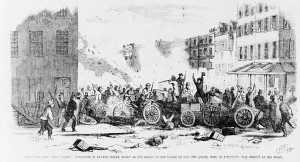In the raucous and often lawless Lower New York City of the nineteenth century, many a vicious gang was berthed in illicit groggeries stashed in the back rooms of corner groceries. But there wasn’t always honor among thieves and sometimes gangs splintered. In his great book, Low Life, Luc Sante relays how such a fragmenting led to the formation and naming of the Dead Rabbits. An excerpt:
“The Roach Guards, named after Ted Roach, the liquor dealer who backed them, suffered a factional dispute some time in the 1830s. During the argument a member of one feuding sector evidently threw a rabbit carcass into the assemblage of the other. These recognized a potent symbol when they saw one and hoisted the corpse as their banner. Henceforth they called themselves the Dead Rabbits, an epithet whose pungency was not diminished by the fact that in flash lingo ‘dead’ was an intensifier meaning ‘best’ and a ‘rabbit’ was a tough guy. Further distancing themselves from their former parent body, the Dead Rabbits sewed red stripes down the outer seams of their pants; the Roach Guards continued to sport blue ones.”
More Afflictor Luc Sante posts:
- Saloon culture in NYC before the Civil War.
- Luc Sante is buried under tons of books.
- Sifting through trash and treasure in NYC in the late-’70s and early-’80s.
- David W. Maurer’s The Big Con.

